
Having a customer acquisition strategy is one of the most important parts of your overall business strategy.
After all, it doesn’t matter how great your product is if no one knows it exists. Product market fit is only the first step.
In this article, you’ll learn the key elements of acquisition strategy, the most common growth engines, and how to choose the right approach. Hopefully, this’ll help you avoid the pain of launching a great product that just cannot seem to reach its target audience.
In simple terms, a customer acquisition strategy is a set of processes and tactics that aim to bring traffic to your product.
These can range from dumping millions of dollars into TV campaigns to building a viral word of mouth.
For product companies, a customer acquisition strategy usually consists of four main elements: Growth engine, fuel, lubricants, and temporary boosts.
Growth engines, sometimes called growth loops, are at the heart of your customer acquisition strategy. There are four primary growth engines:
A growth engine answers the question of how your product can sustainably attract new users and how those new users can lead to more new users over time.
The truth is that 80 percent of your customer acquisition strategy success depends on choosing the right engine of growth for your product.
Fuel is what makes your growth engine work. The more fuel you have, the more new customers you can acquire.
For example, if you’re betting your acquisition strategy on company-generated blog content, the fuel is the pieces of content. The more content you publish, the more fuel your SEO engine has.
Lubricants are what makes your growth engine efficient.
Back to the SEO engine example, although pieces of content are your engine’s fuel, if they’re low quality, target irrelevant keywords, and don’t have any backlinks, they won’t take you far.
On the other hand, growth lubricants aim to maximize ROI for a unit of fuel you put through your growth engine.
Although a healthy, well-oiled growth engine with abundant fuel is all you need for a sustainable customer acquisition strategy, you can also experiment with more ad-hoc initiatives.
Temporary boosts are one-time activities that can help you gain traction in customer acquisition.
Say you’re a software house that relies mostly on performance marketing to gain customers. Although this is your primary source of customers, you can also speak at technology-related conferences to demonstrate your expertise and gain new prospects.
Although speaking at conferences isn’t a sustainable long-term acquisition strategy, it can give you a temporary boost when needed.
Figuring out your potential temporary boots upfront will help you react faster in situations when you need to boost acquisition fast.
There are four main growth engines that you can utilize for your customer acquisition strategy: SEO, virality, performance marketing, and sales.
Search Engine Optimization (SEO), sometimes referred to as “organic acquisition,” is one of the most common acquisition models out there.
SEO engines can be split into two categories:
For user-generated content, this engine works in the following way:
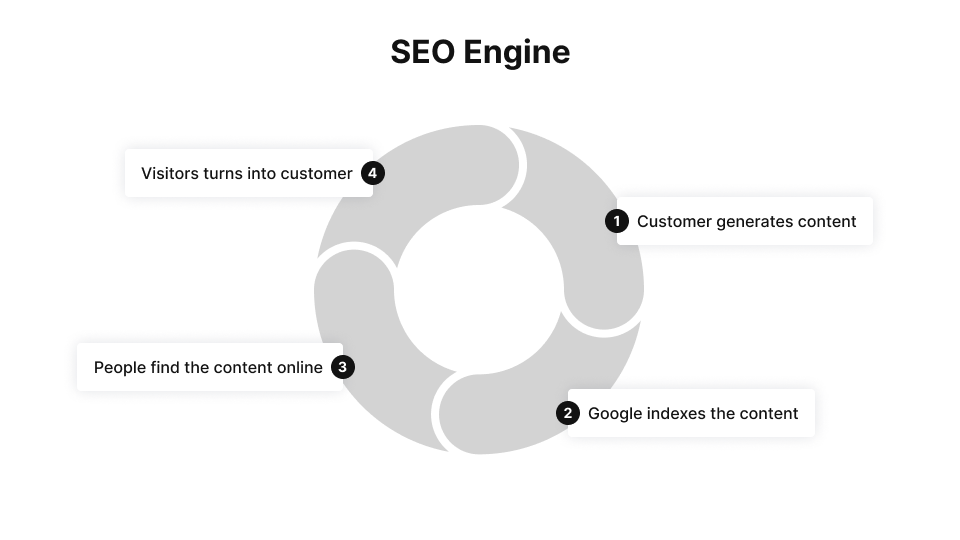
On the other hand, SEO engines based on company-generated concepts work similarly to performance marketing:
For an SEO engine, the main source of growth is the pieces of content produced. The more content there is, the higher the chance that new visitors will find it on the search engine.
To maximize the ROI out of the content you produce, you should optimize for:
New customers per piece of content.
A virality-focused customer acquisition strategy is all about either word of mouth or intentional invitations. In this model, most of your growth comes from your current users inviting new users:
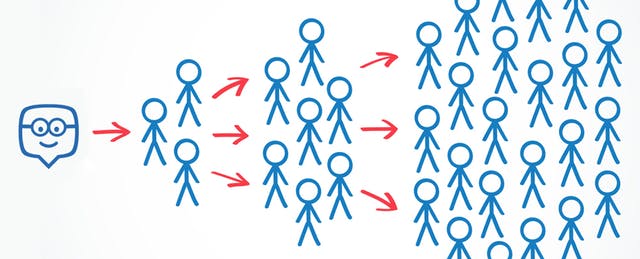
The engine is built on three main steps:
Customer acquisition strategies of almost all social platforms, such as LinkedIn or Facebook, are built on viral growth engines.
The virality model is all about the scale. You can’t build a viral product if you only have one customer.
The more people on your product, the healthier your virality engine.
There are two main things to optimize for in viral growth models:
Virality coefficient (How many new customers a single customer brings?).
Performance marketing is all about putting money into paid growth channels, especially advertising.
This is a pretty straightforward engine:
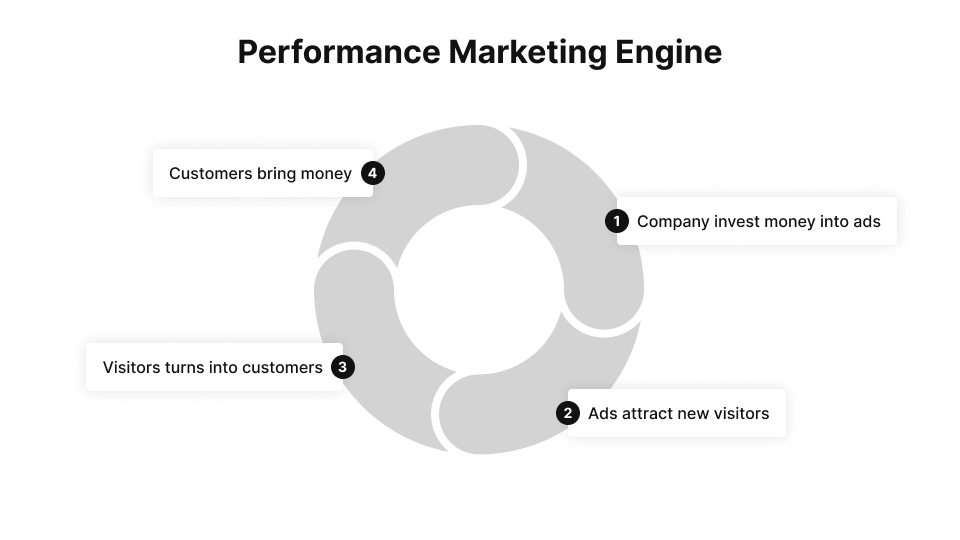
The best part of performance marketing is the fact that it can start work well from day one, while SEO and virality require time to pick up.
Capital is the primary constraint of performance marketing. The more money you can put into your marketing budget, the more new customers you can get.
Since money is the main fuel of this engine, you need to optimize for two main metrics.
Customers per $1 spent.
Let’s not forget about the good old sales.
The sales engine goes something like this:
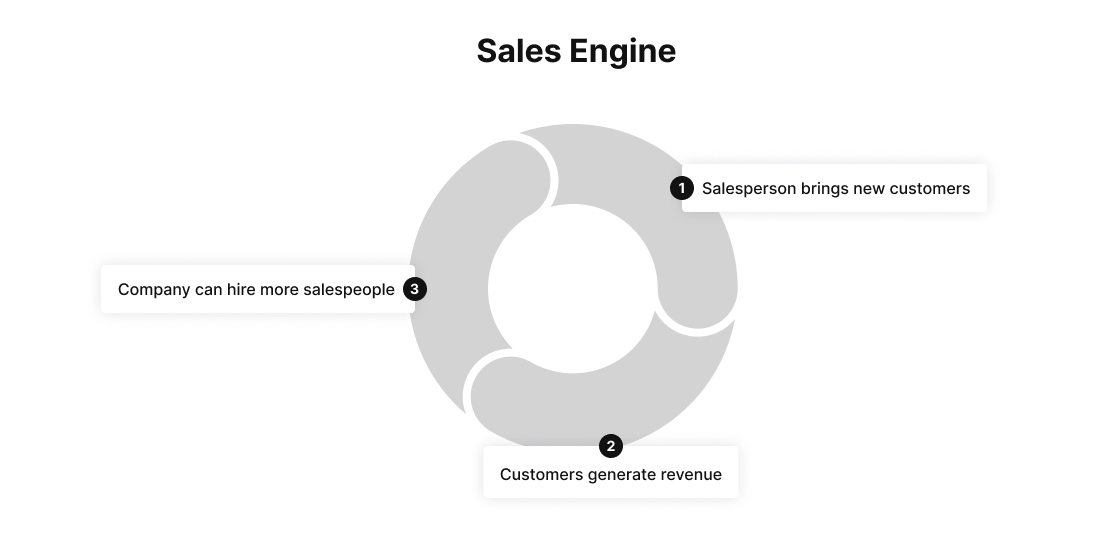
This model works especially well if you are targeting a few but high-value customers or if your product is complex to explain and requires human explanation to understand fully.
The sales acquisition model is all about the size of your sales team. The more salespeople you can get on board, the more customers you’ll close.
The primary metrics to optimize for are:
ROI per salesperson.
Now that you have a sense of the four most common approaches to a customer acquisition, you might be asking yourself how you can choose the right one.
Although the exact answer depends on a variety of factors, the following provides a general framework:
Choose performance marketing if:
Choose SEO if:
Choose virality if:
Choose sales if:
Although usually unsustainable, boosts are essential to your customer acquisition strategy for a few reasons. Boosts can:
Here’s a list of potential boosts you might want to try out:
The list above is just a starting point. Anything that can give you a spike in acquisition in a short time is a worthy acquisition boost.
Building a great product is just the first step. You also need to let people know it exists. This is why it’s imperative to think about a solid customer acquisition strategy from day one.
There are many ways to describe customer acquisition strategy, but I find the car analogy the easiest. There are basically four main components:
Choose the engine that best fits your product, make it efficient by optimizing relevant sub-metrics, and put as much fuel through it as you can. Don’t forget to treat yourself to an occasional boost every now and then too!
Featured image source: IconScout
LogRocket identifies friction points in the user experience so you can make informed decisions about product and design changes that must happen to hit your goals.
With LogRocket, you can understand the scope of the issues affecting your product and prioritize the changes that need to be made. LogRocket simplifies workflows by allowing Engineering, Product, UX, and Design teams to work from the same data as you, eliminating any confusion about what needs to be done.
Get your teams on the same page — try LogRocket today.
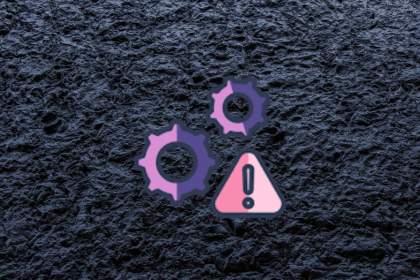
Act fast or play it safe? Product managers face this daily. Here’s a smarter way to balance risk, speed, and responsibility.
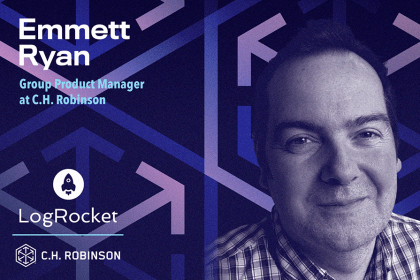
Emmett Ryan shares how introducing agile processes at C.H. Robinson improved accuracy of project estimations and overall qualitative feedback.
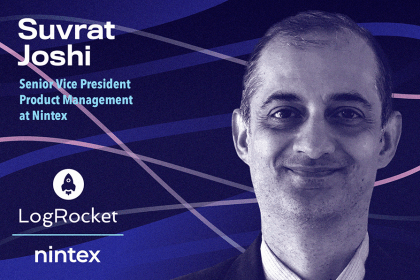
Suvrat Joshi shares the importance of viewing trade-off decisions in product management more like a balance than a compromise.

Great product managers spot change early. Discover how to pivot your product strategy before it’s too late.